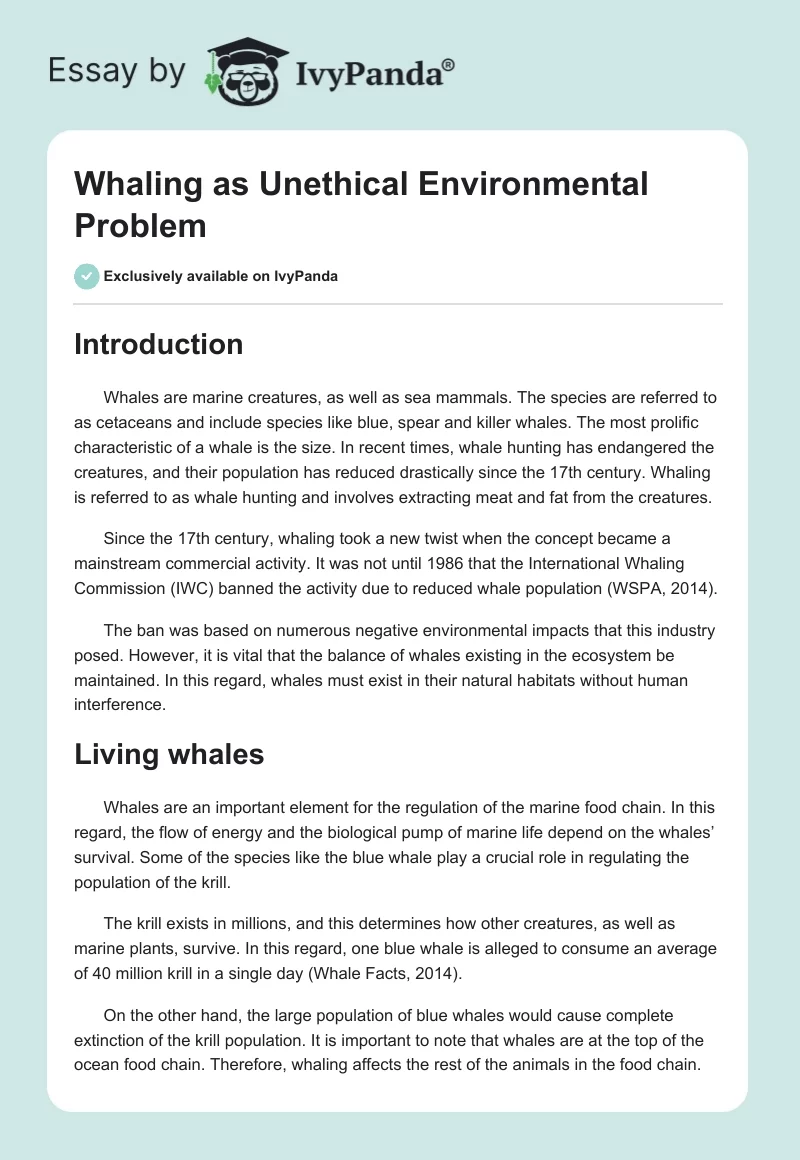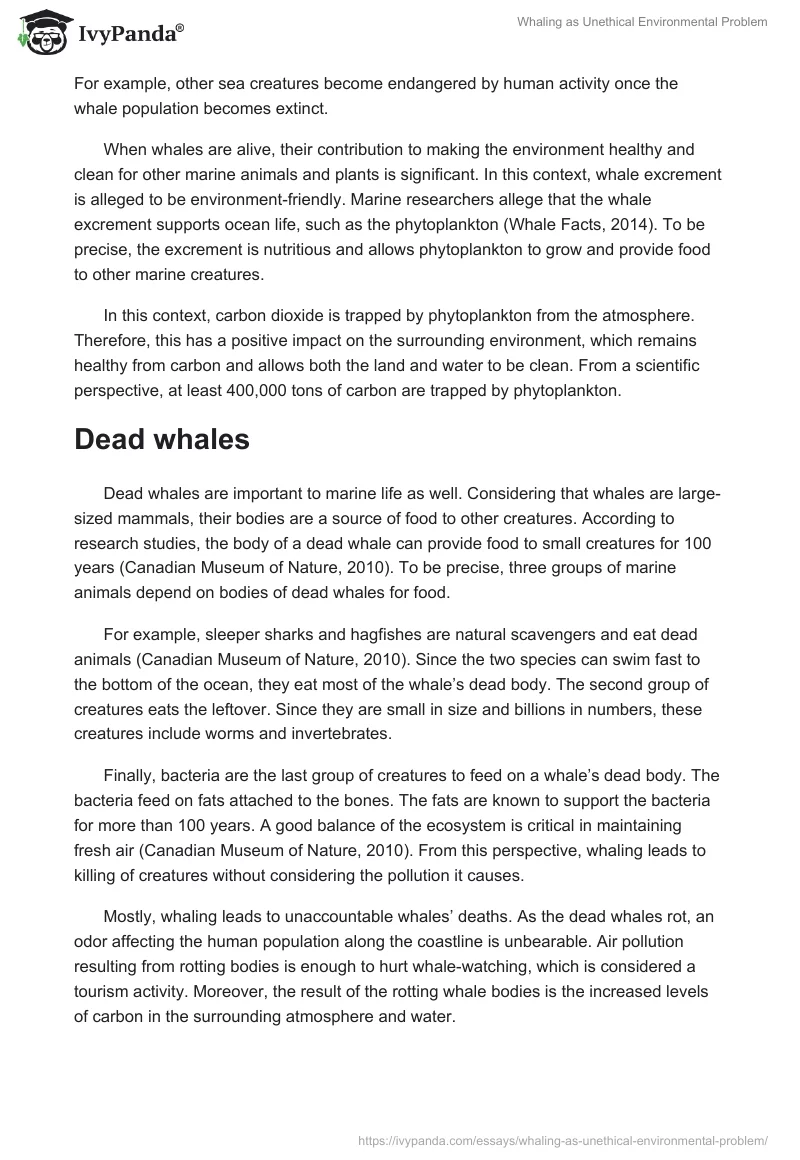Introduction
Whales are marine creatures, as well as sea mammals. The species are referred to as cetaceans and include species like blue, spear and killer whales. The most prolific characteristic of a whale is the size. In recent times, whale hunting has endangered the creatures, and their population has reduced drastically since the 17th century. Whaling is referred to as whale hunting and involves extracting meat and fat from the creatures.
Since the 17th century, whaling took a new twist when the concept became a mainstream commercial activity. It was not until 1986 that the International Whaling Commission (IWC) banned the activity due to reduced whale population (WSPA, 2014).
The ban was based on numerous negative environmental impacts that this industry posed. However, it is vital that the balance of whales existing in the ecosystem be maintained. In this regard, whales must exist in their natural habitats without human interference.
Living whales
Whales are an important element for the regulation of the marine food chain. In this regard, the flow of energy and the biological pump of marine life depend on the whales’ survival. Some of the species like the blue whale play a crucial role in regulating the population of the krill.
The krill exists in millions, and this determines how other creatures, as well as marine plants, survive. In this regard, one blue whale is alleged to consume an average of 40 million krill in a single day (Whale Facts, 2014).
On the other hand, the large population of blue whales would cause complete extinction of the krill population. It is important to note that whales are at the top of the ocean food chain. Therefore, whaling affects the rest of the animals in the food chain. For example, other sea creatures become endangered by human activity once the whale population becomes extinct.
When whales are alive, their contribution to making the environment healthy and clean for other marine animals and plants is significant. In this context, whale excrement is alleged to be environment-friendly. Marine researchers allege that the whale excrement supports ocean life, such as the phytoplankton (Whale Facts, 2014). To be precise, the excrement is nutritious and allows phytoplankton to grow and provide food to other marine creatures.
In this context, carbon dioxide is trapped by phytoplankton from the atmosphere. Therefore, this has a positive impact on the surrounding environment, which remains healthy from carbon and allows both the land and water to be clean. From a scientific perspective, at least 400,000 tons of carbon are trapped by phytoplankton.
Dead whales
Dead whales are important to marine life as well. Considering that whales are large-sized mammals, their bodies are a source of food to other creatures. According to research studies, the body of a dead whale can provide food to small creatures for 100 years (Canadian Museum of Nature, 2010). To be precise, three groups of marine animals depend on bodies of dead whales for food.
For example, sleeper sharks and hagfishes are natural scavengers and eat dead animals (Canadian Museum of Nature, 2010). Since the two species can swim fast to the bottom of the ocean, they eat most of the whale’s dead body. The second group of creatures eats the leftover. Since they are small in size and billions in numbers, these creatures include worms and invertebrates.
Finally, bacteria are the last group of creatures to feed on a whale’s dead body. The bacteria feed on fats attached to the bones. The fats are known to support the bacteria for more than 100 years. A good balance of the ecosystem is critical in maintaining fresh air (Canadian Museum of Nature, 2010). From this perspective, whaling leads to killing of creatures without considering the pollution it causes.
Mostly, whaling leads to unaccountable whales’ deaths. As the dead whales rot, an odor affecting the human population along the coastline is unbearable. Air pollution resulting from rotting bodies is enough to hurt whale-watching, which is considered a tourism activity. Moreover, the result of the rotting whale bodies is the increased levels of carbon in the surrounding atmosphere and water.
Conclusion
Whaling has been in existence for many years until in the late 1980s (WSPA, 2014). However, the main concern for banning whaling was due to the environmental effects emanating from the same. Considering how the environment benefits from the whales, whether alive or dead, hunting the marine creatures is unethical. Disrupting the marine life, as well as the flow of energy, is critical and leads to significant environmental consequences.
A life that depends on whales, whether alive or dead, becomes endangered with increased whaling. The negative environmental impact of marine life does not affect sea creatures only, but also human life. As indicated earlier, whales play a crucial role in maintaining clean air and water. Therefore, whaling causes air and water pollution and other environment-related health hazards.
References
Canadian Museum of Nature. (2010). What happens when a whale dies? Food for the depths. Web.
Whale Facts. (2014). Blue whale facts (Balaenoptera Musculus).
WSPA. (2014). After the ban, whaling continues. Web.


